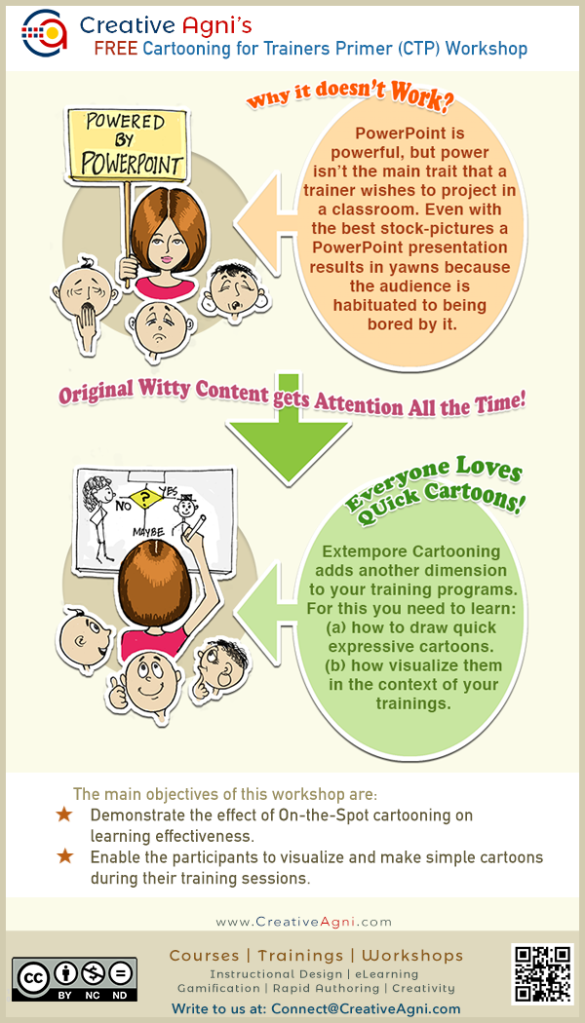In my previous post, I raised a question that was inspired by an IDCWC Online Course Participant. The question was, “Is Design an Inhibitor?”
I received a detailed thought-provoking response to that question from Tricia Pottratz. You can visit her new but promising blog “Tricia’s Teacher Toolbox” here. Thank you, Tricia.
Here are Tricia’s thoughts.
Having designed many classes myself, I understand where you are coming from. Curriculum seems to take on a life of its own. Once written, it becomes what the instructor deems it to be. I think a big part of that comes from two sources: who you are designing for and what your objectives are. I work for a multi-million dollar for-profit corporation with campuses all across the United States. Before our small campus was purchased, instructors had the academic freedom to modify curriculum to meet their needs while still teaching to the objectives. The key was in keeping the objectives simple and few.
Since the buyout, the curriculum has evolved. The first revision was similar to the original, but the coming revision is vastly different. Sadly, the objectives are many and room for changes is few. The idea is to create uniformity across the company; however the result is that the company’s curriculum does not leave much room for interpretation or regional flavor.
The solution depends on the parameters. If you have any flexibility or say in the curriculum, I would suggest creating simple objectives, which leave the instructor the room for interpretation. A really good article at http://itdl.org/journal/sep_05/article03.htm suggests that to be effective at brain-based learning, instructors should incorporate 4 basic things: memory and retrieval, learning styles, attention, and emotion (Clemons, 2005). I find that in order to accomplish those goals it is important to offer a variety of media and classroom activities that vary in size and scope.
The other two-edged sword in education is the rubric. As an instructor and as a student, I love the fact that it sets specific parameters. The dilemma is still the same: the more specific the objectives, the less creative the project. I have found that the only way to overcome this is to allow for students to develop the rubrics themselves. After all, if you give a template, they will only follow the template. This line of thinking also works in the classroom: if the students design the projects (based on the learning objectives) they become more emotionally involved and willing to go further with the project than I would have ever expected.
A friend of mine also suggested going with a tiered learning system. Her argument is that it gives options for the students while still ensuring the quality of the project is within the set parameters. My problem with tiered learning systems is that it is not always feasible and can create conflict in the classroom. I am more for offering options with a similar difficulty level instead of varying the levels. In that way the “slower” student does not feel like they are being singled out and the “quick learner” is not feeling like it is unfair in the classroom.
Have you ever had any luck with tiered learning in the classroom? If so, I would love to hear about it.
Sincerely,
Tricia Pottratz, BS, LMP
I attempted to address Tricia’s question by sketching a paradigm with two basic assumptions. 1. The learners are all adult learners. 2. The learners constitute a heterogeneous group, especially in terms of their existing skills and/or their ability to learn.
I believe that the answer has to be chiseled out from the goal of a training program. What is it that you want to achieve for your group? Notice that I don’t speak of what the learners want to achieve, but what “you, a representative of the learning provider” wish to achieve.
Let me illustrate through three simple examples:
1. You wish to orient the learners towards a new corporate policy.
—————————————————————————————-
This is a lower level goal of awareness generation. You might want to use a tiered system here. You can create your learning groups on the basis of individual motivation and learning ability. At least everyone would take away something. As you won’t be grading their performance in this sort of program, you will possibly see a lot of happy faces at the end of your training.
2. You wish to train the learners on a specific role-based skill so that they can do their job proficiently.
—————————————————————————————-
I don’t think that a tiered system will help you achieve you goal in this case. You need everyone to reach approximately the same level in the new skill. Eventually everyone might not reach the desired level, but then you’d like to see the distribution of marks and ensure that only those who reach the required level of competency are certified to do the job.
However if your program is flexible enough to accommodate the slow learners by allowing them additional practice/time, tiered learning may work. (We should also review the impact of this on learner motivation and individual egos.)
3. You wish to train the learners for a skill that demands accuracy and precision (for instance: a career in medicine?)
—————————————————————————————-
Attempt to take all the learners to the same level, and use the rubrics wisely to grade the post-training skills. Sometimes the assessments have to be done against very specific objectives. I think that creativity is related more to the content-type than to the specificity of the objectives – especially when you create the learning and reinforcement activities.
I should also mention that I completely agree with Tricia’s belief that allowing the learners to participate in the creation of the assessment rubrics is a double-edged sword. I think it could work well with a group of mature and motivated participants, but not otherwise.
I know that heterogeneous groups are a reality and this reality contradicts the dream that every trainer and instructional designer has, which is 100% learning effectiveness.
A Note for the regular readers, who might’ve been wondering why my previous two posts have been replete with ATDs: I guess my excuses are the same as the ones given by everyone else – I was too tired and a little ill, and then I was busy trying to meet the deadlines for my deliverables and delivering on my promises – but then, excuses don’t help, do they? So, I spent some time going through whatever I had written and removed the ATDs …thanks to a cup of coffee and the zoom-in capability of my new laptop. I prefer not to get my stuff edited (for better or for worse, this is how I write,) so bear with me…and ignore the bad to focus on the good 🙂




